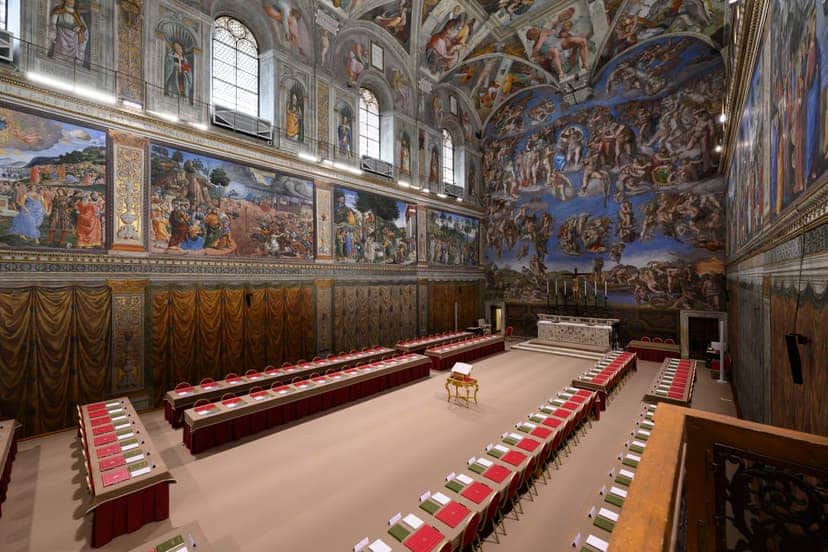The first all-important smoke signal of the conclave came unusually late, set against a rapidly darkening sky over the Vatican yesterday. It followed a sermon given ahead of the conclave which appeared to indirectly offer some criticism of Pope Francis's legacy and thereby suggest what needs to come next when the cardinal-electors cast their votes.
Cardinals enclosed in the Sistine Chapel to elect the new pope cast their first ballot early evening on Wednesday, 7 May, while a massive crowd gathered outside of St. Peter’s Basilica to watch for that first smoke signal from the conclave to elect a successor to Pope Francis and the Catholic Church's 267th pope.
While the voting sessions usually last around an hour and a half to two hours, Wednesday’s first session was unusually long, with the chapel doors closing around 6 p.m. local time, and the smoke not emerging from the chimney until after 9 p.m., keeping the tens of thousands gathered below to see the smoke waiting.
Earlier on Wednesday, Italian Cardinal Giovanni Battista Re, 91, presided over an inaugural Mass for the conclave, which may have contained its own signals to the 133 cardinal-electors about how they should vote (Re is unable to vote due to being over the voting age cut-off of 80).
Re in his homily notably did not quote any of Pope Francis’s magisterial documents, which was seen as a slight to Francis and a signal to the cardinals that he believes the next papacy ought to go in a different direction – it is customary to quote the recently-deceased pontiff in an inaugural conclave Mass.
The perception is that institutional cardinals, those within the Curia, are eager to change course after a pope who largely worked around or in spite of his system, rather than with or through it. Francis often made decisions on his own without consultation and without giving notice to the Curia.
Some cardinals, because of this, are seen as eager to backpedal on Francis’s curial reforms, and Re’s homily was interpreted as backing this approach, with Parolin as his candidate of choice.
However, with so many cardinals from around the world, including the global peripheries that Pope Francis so insistently sought to shed light on, what will happen, and what direction the next papacy will take, is still very much an open possibility.
Some feel that Re actually offered a show of support for Italian Cardinal Pietro Parolin – considered a frontrunner in the conclave – during the inaugural Mass by giving him a warm embrace on the altar.
The conclave was officially inaugurated on Wednesday, May 7, with a Mass celebrated <em>Pro eligendo Romano Pontifice</em> (“For electing the new pope") in St. Peter’s Basilica.
Cardinals then had a break for lunch and rest before making a formal procession from the Vatican’s Pauline Chapel into the Sistine Chapel, where they swore a collective and individual oath of secrecy.
An <em>extra omnes</em> command was then given ordering all of the “extras”, or those present but not voting in the conclave, to leave, and the doors of the Sistine Chapel were closed, signaling the official start of the conclave.
There were likely many reasons for the delay around the first ballot, including the fact that before voting began, former papal preacher Italian Cardinal Raniero Cantalamessa, 90, gave a reflection to cardinals that lasted around 45 minutes.
Afterward, there was presumably an explanation of the voting process for cardinals unfamiliar with the process, and potentially in different languages.
Once the vote began, each of the 133 cardinals went up to place their slip of paper containing the name of their candidate into an urn set up in front of Michaelangelo’s Last Judgement. Votes then had to be counted and recounted to verify the numbers.
For a conclave with more electors than the previous conclaves of 2005 and 2013, 80 per cent of whom were named by Pope Francis and thus have never participated in a conclave, the delay was unusual, but not concerning.
Many cardinals appointed by Pope Francis also come from remote and faraway countries and do not know Italian, the official working language of the Holy See, meaning it might have taken longer to explain the process.
Meanwhile, the streets outside of the Vatican were packed with faithful, tourists and spectators hoping to see the first “smoke” of the conclave – the moment white or black smoke comes pouring out of the chimney of the Sistine Chapel with the burning of the ballots for that voting session.
Black smoke, colored with sulfur to make it dark, means no pope has been elected, whereas white smoke indicates the cardinals have selected a new pope, who reached a two-thirds majority vote – in this case, 89 of the 133.
Only one voting session was held Wednesday; however, from Thursday onward there will be four voting sessions a day, two in the morning and two in the evening, until a pope is elected.
While previous conclaves in 2005 and 2013 were relatively short, resulting in a pope after just two days, this one is expected to last longer, as there are more cardinals voting, and thus more options and opinions about the right candidate.
Many cardinal-electors were unknown to one another prior to coming to Rome for Pope Francis’s funeral and the conclave process, meaning it could take longer to identify candidates and reach a consensus.
<a href="https://thecatholicherald.com/this-conclave-looks-set-to-be-a-long-hard-fight/"><mark style="background-color:rgba(0, 0, 0, 0)" class="has-inline-color has-vivid-cyan-blue-color"><strong><em>RELATED: Could this be the longest conclave in modern history?</em></strong></mark></a>
<em>Photo: The Sistine Chapel inside Vatican City is set up for the conclave that will elect the next pope after the death of Pope Francis, Vatican, 6 May 2025. (Credit: Vatican Media.)</em>



